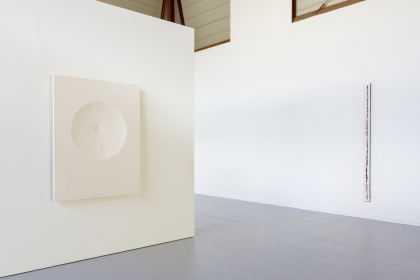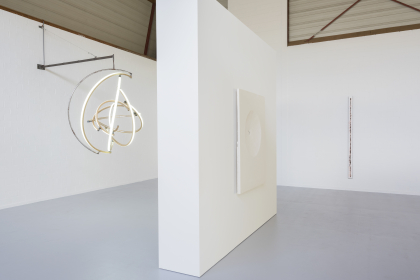
Blood, sweat and tears. Labour is important to Brecht Heytens. Time and energy are an elementary part of his work as a visual artist. His physical presence, and both his personal knowledge and his ignorance, are essential. He immerses himself in the possibilities of a number of materials – wood, metal, plaster and light – and drives them to their extremes in order to achieve his preconceived ideas. In so doing, he makes different choices to those of craftsman or factory workers, because the most logical or practical option does not always appeal to him. The execution must match the sketch in his head as closely as possible, even if this demands tons of energy, experimentation, and patience.
The selection of materials with which he constructs his sculptures is limited, yet diverse. For most sculptors, plaster is associated with an intermediate phase in the process towards the finished artwork. Brecht Heytens is highly familiar with plaster, deploying it with the utmost purity in his 2016 graduation project at Sint-Lucas in Brussels. He plays with the adhesive strength and plasticity of the material. The fragility of the plaster stands in stark contrast to the less-malleable metal. Brecht Heytens plays with the materials’ contradictions, but also with the way in which they influence one another and flow together. The traces of metal in plaster act as three-dimensional graphics. Another very different dynamic is introduced through a natural material like wood. The artist uses a variety of techniques to render the wood moveable, which creates a decorativeness and intimacy. The warmth and homeliness of the wood, the industrial cold metal, supplemented by the artistic playfulness of plaster are different physical formal languages that are challenged by the immateriality of light. But Heytens uses neon lamps – ecological considerations have now prompted him to switch to LED – in different constellations, colours, and figures. The presence of light makes his sculptures elusive and hard to grasp. The light is the active protagonist, without reducing the other elements to mere supports.
All these materials reveal the labour that has gone into the finished artwork. In other words, Brecht Heytens does not choose the most obvious way of combining the different components. Everything is in proportion to the aesthetic and the physical connection between the artist and his work. The personal actions are visible in the finish; plaster sanded down by hand until a hole appears, for example. For another work he throws plaster against a lamp, and its adhesive strength makes it stick to the wall. This act can only be performed in situ, which turns the exhibition space into a workshop where artworks are produced. The studio is primarily a place for thinking, preparation, storing materials; and a place for exploring the possibilities of materials.
The majority of works are conceived for a specific space, to which they are attuned. The White House Gallery is the first to exhibit a range of different sculptures and wall installations, thus providing an overview of Brecht Heytens’ artistic practice from 2016 to the present day.
Ilse Roosens









